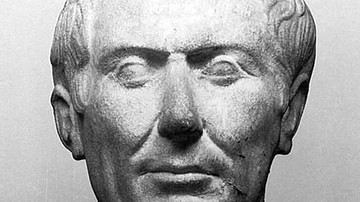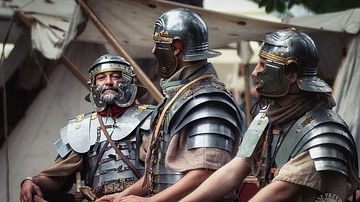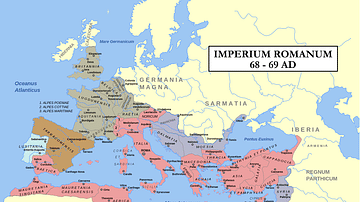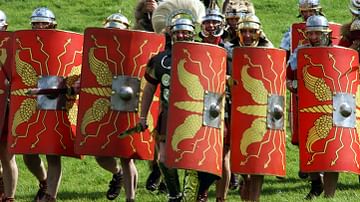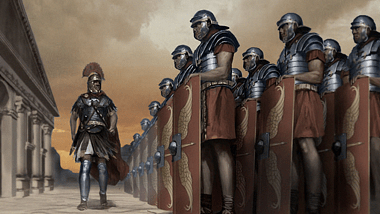
Legio V Alaudae, referenced in early accounts only as the "Fifth", was one of the many legions of the Roman army that helped Julius Caesar (100-44 BCE) to achieve success as a military commander in Gaul, Spain, and Africa. Later stationed along the Rhine, it participated in many Germanic campaigns until it was supposedly annihilated in Domitian's Dacian campaign.
Origin
In the time of Caesar and Pompey (106-48 BCE), the legions of the Roman Republic were known only by a number, not a name. Over time, to avoid confusion, this would change. Legio Quinta Alaudae’s beginning is uncertain. Dando-Collins asserts that a legion known as the "Fifth" and under the command of Pompey may have been among those that surrendered to Caesar in Spain in 49 BCE. In the following year, Caesar ordered the governor of Hispania Ulterior (Further Spain), Quintus Cassius Longinus, to create a new legion, the Fifth, from remnants of Pompey’s old disbanded legion.
However, historian Nigel Pollard in his The Complete Roman Legions writes that the V Alaudae (referred to as V) was formed in 52 BCE along with VI for use in Caesar’s Gallic Wars. It was one of the twelve legions he used during his conquest of Gaul. In his Twelve Caesars, historian Suetonius (c. 69 - c. 130/140 CE) wrote of Caesar’s desire to retain his position as a military commander and governor of Transalpine Gaul. His eventual success in keeping his governorship "encouraged Caesar to expand his regular army with legions raised at his own expense - one even recruited in Transalpine Gaul and called by the Gallic word "Alauda" which he trained and equipped in Roman style. Later he made every Alauda legionary a full citizen" (11). The word Alauda means "lark" and references the crest of the bird’s feathers. It is likely that the Fifth and Alauda legion eventually merged and became the Legio V Alaudae. Whether it was formed in 48 BCE or 52 BCE, in the heat of the Civil War, the legion funded from Caesar's private purse was sent to North Africa to participate in Caesar’s African campaign.
In April of 46 BCE, at the Battle of Thapsus, Caesar and his legions - among them were II, V, VIII, IX, and X - fought against the 60 elephants of King Juba I of Numidia (r. 60-46 BCE). The battle was largely waged between Caesar and Quintus Scipio, leader of the Optimate forces, Ceasar's Republican enemies, in one of the last encounters of the Civil War. In the end, Scipio’s army panicked and was destroyed. Caesar proved victorious. Although some claim suicide after the lost battle, Scipio drowned returning to Spain while King Juba was banished by his own people. As a result of the war, Cato the Younger (95-46 BCE), Caesar’s nemesis, committed suicide. It was at Thapsus that the V Alaudae legionaries earned the emblem they would carry on their shields, the elephant.
Elephants appear terrifying in battle but are difficult to control. According to Philip Freeman in his Julius Caesar, a crazed elephant pinned down a camp follower, and one of the veteran legionaries from Legio Quinta Alaudae attempted to help but was grabbed by the elephant and lifted into the air. The legionary hacked at the elephant until he was finally released. V Alaudae was the only Caesarian legion that did not have the bull as its emblem.
The Fifth continued to see additional action under Caesar. In March of 45 BCE, Caesar and his legions confronted the brothers Pompey, Gnaeus and Sextus, and the former Roman commander Titus Labienus at the Battle of Munda in Spain. According to Barry Strauss in his Masters of Command, Caesar had eight legions, which included the veterans of the Fifth and Tenth along with 8,000 cavalry opposing the 13 legions of the Pompeian forces. The Fifth covered the left flank along with the Third. Eventually, the battle turned into a rout, killing 53,000 of the Pompey troops. With Caesar's victory at Munda, the Spanish campaign was completed and the Civil War was over.
Although having fought under Mark Anthony as one of his 23 legions at the Battle of Actium, Legio V Alaudae would later serve with Augustus (r. 27 BCE - 14 CE) in his Cantabrian Wars in Spain. In 19 BCE, at the end of the wars, V Alaudae was transferred and became one of the Legions of the Rhine frontier alongside the Legio VIII Augusta, Legio XXII Primigenia, and Legio XXI Rapax.
The Lost Eagle
In 16 BCE, the V Alaudae fought under the governor of Germania Inferior Marcus Lollius against the invading German tribes of the Sugambri, Usipetes, and Tencteri. A Germanic raid had seized Romans traveling through their territory and crucified them. With the realization that the Romans would retaliate, the tribes crossed the Rhine into Roman territory where they repulsed a Roman cavalry sent by the governor to intercept the invaders. The cavalry was ambushed and forced to retreat, leading the Germans to the location of the Roman infantry.
During the subsequent skirmish, the V Alaudae fought bravely but lost their eagle and was forced to withdraw. The eagle would be discovered during Trajan’s (r. 98-117 CE) of Dacian Wars. Lollius retreated and attempted to build a larger force. However, when the German invaders received news of the Roman army under Augustus in retreat, they withdrew across the Rhine with their accumulated loot. A peace agreement was soon reached. Because of his poor leadership, Lollius’ military career was ruined. Suetonius wrote of the incident:
He [Augustus] suffered only two heavy defeats, both in Germany, the generals concerned being Lollius and Varus. Lollius’ defeat was ignominious rather than of strategic importance, but Varus’ nearly wrecked the empire… (54)
The defeat and routing of Lollius' infantry did not go without comment from the historian Tacitus (c. 56 - c. 118 CE). In his Annals of Imperial Rome, he wrote of the time following the death of Caesar’s assassins. "After that, there had certainly been peace, but it was a bloodstained peace. For there followed the disasters of Marcus Lollius and Publius Quinctilius Varus …" (38) The Lollius disaster was an indication of potential problems on the Rhine frontier.
Mutiny
Despite losing its eagle and the shame it brought, the legion would remain active. In 6 CE, they partook, alongside eleven other legions, in Tiberius’ (r. 14-37 CE) force assembled to battle the Marcomanni, but the assault was discontinued due to the Pannonian Revolt. The legion’s next encounter was not against an enemy of the empire but against the Roman government. In 14 CE, after the death of Augustus, the V Alaudae, XXI Rapax, and I Germanica were part of a mutiny, citing poor conditions of service, most importantly pay. Acting on behalf of Rome, Germanicus, stepson of Roman emperor Tiberius, negotiated with the mutineers and was able to console some of their demands. Tacitus wrote:
The soldiers saw that these concessions were hastily improvised and demanded their immediate implementation. … The cash payments, however, were held up until the troops reached winter quarters. Two brigades, the fifth and twenty-first, refused to move from their summer quarters until, there and then, the whole sum was paid. (54)
The legions V Alaudae and XXI Rapax could not be appeased. Tacitus added:
This [payment] relieved the immediate crisis. But there was still equally serious trouble with the truculent attitude of the fifth and twenty-first brigades wintering sixty miles away at Vetera. It was they who had started the mutiny and committed the worst atrocities. Now they were as angry as ever, undeterred by the punishment and contrition of their fellow-soldiers… (58)
Germanicus waited with counter-measures against the mutineers and even threatened to execute the mutineers unless the commander Aulus Caecina punished them. With a force of loyal legionaries, Caecina entered the mutineers’ tents and killed the offenders. Germanicus called the commander’s solution a catastrophe and ordered the bodies to be cremated. Later, in 15 CE, the legion was able to redeem themselves when they joined I Germanica, XX, and XXI Rapax under the commander Caecina in the Battle of the Long Bridges against the Germans. "The fifth brigade was chosen for the right flank, and the twenty-first left; the first was to be vanguard, and the twentieth to hold of pursuers" (Tacitus, 69). It was after the battle that I Germanica earned its name.
Germanic Campaigns
The legion participated in Germanicus’ campaigns in Germany as well as Lucius Apronius’ battle against the Frisii in 28 CE, when the Roman forces were been beaten back and in disarray. The commander of the Fifth, Cethegus Labeo, found his legion’s position critical. Tacitus in his Annals wrote of the Fifth legion’s bravery in battle: "The soldiers of the fifth sprang forward, drove back the enemy in a fierce encounter, and saved our cohorts and cavalry, who were exhausted by their wounds." (73) In the end the Roman legions were able to fight off the Germans.
Remaining stationed at Vetera (Xanten, Germany), little is known of the legion’s activities until 69 CE, the Year of the Four Emperors. Many within the legion were reluctant to swear allegiance to the new emperor Lucius Galba (r. 68-69 CE), supporting the governor of Germania Inferior, Vitellius, instead. One or more of the legion’s cohorts joined Vitellius in his battle against Galba’s successor, Marcus Otho, in the Battle of Bedriacum. The remainder of the legion, with the XV Primigenia, remained at Vetera under Munius Lupercus and battled the rebel Bavarian cavalry under the leadership of Civilis. The two legions were able to withstand the Batavian Revolt for over a year.

Finally, Civilis embarked on a starvation siege. After exhausting their supplies and realizing they were alone in the fight, the 4,000 legionaries surrendered, leaving their Roman armor and weapons behind. After going only five miles (8 km) from the fortress, the Germans surrounded the unarmed legionaries and slaughtered them. Only 1000 legionaries were able to make it back into the fortress. Civilis set the fort on fire; all of those inside perished. Dando-Collins writes that Civilis had captured every Roman base on the Rhine thereby fulfilling his vow: to deliver his people from Roman control.
Annihilation
After the disaster at Vetera, the fate of the V Alaudae is unclear. Nigel Pollard claims the legion may have been disbanded along with I Germanica and XV Primigenia. However, Dando-Collins wrote that the legion was transferred to the Balkans by Emperor Vespasian (r. 69-79 CE). In 86 CE, the new king of Dacia, Decebalus, invaded the Roman province of Moesia. With the V Macedonica alongside him, the provincial governor Oppius Sabinus marched unsuccessfully against the Dacians. The governor was among the heavy casualties, forcing the legion to retreat. Responding to the defeat, Emperor Domitian (r. 81-96 CE) went on the offensive. The legions of the Dacian Wars led by the prefect of the Praetorian Guard Cornelius Fuscus crossed the Danube and were immediately attacked by Decebalus. Although sources disagree, during the assault, the V Alaudae was supposedly annihilated, and it was never reformed.




